New York City Ballet / New York State Theater, Lincoln Center, NYC / January 6 – February 29, 2004
Dancing, which happens in space and time, is three-dimensional. (For this reason, the camera can never quite seize it.) At the New York City Ballet, in the two decades that have elapsed since George Balanchine’s death, the master’s repertory has drifted ominously toward the two-dimensional condition Edwin A. Abbott described in his Flatland 120 years ago.
I call our world Flatland, not because we call it so, but to make its nature clearer to you, my happy readers, who are privileged to live in Space.
Imagine a vast sheet of paper on which straight Lines, Triangles, Squares, Pentagons, Hexagons, and other figures, instead of remaining fixed in their places, move freely about, on . . . or in the surface, but without the power of rising above or sinking below it, very much like shadows — only hard with luminous edges. . . . In such a country, you will perceive at once that it is impossible that there should be anything of what you call a “solid” kind; but I dare say you will suppose that we could at least distinguish by sight the Triangles, Squares, and other figures, moving about as I have described them. On the contrary, we could see nothing of the kind, not at least so as to distinguish one figure from another. Nothing was visible, nor could be visible, to us, except Straight Lines. . . .
I do not, of course, mean that there are not battles, conspiracies, tumults, factions, and all those other phenomena which are supposed to make History interesting; nor would I deny that the strange mixture of the problems of life and the problems of Mathematics . . . imparts to our existence a zest which you in Spaceland can hardly comprehend. I speak now from the aesthetic and artistic point of view when I say that life with us is dull; aesthetically and artistically, very dull indeed.
I noticed this resemblance especially watching Concerto Barocco this season, danced by the cast in which Jennie Somogyi takes the role of the second leading woman (the one who doesn’t do the pas de deux). Somogyi stands out from the majority of her colleagues in the company because she’s the epitome of the Spaceland dancer. She seems robust in every sense, larger than life. When she moves, you see flesh, bone, and muscle. You see crystalline images magnified. You get gorgeous sculptural effects. You get rubato—a constant variation in the degree of emphasis given to the parts that make up the whole—which animates the dancer’s entire utterance. All this has become the rarity at NYCB; once it was the norm.
Somogyi’s vitality has stood out for several years now, partly because it is truly extraordinary—in the old days, a dancer of her mettle would have given Maria Tallchief a run for her money—partly because of the salutary shock it provides when set against the prevailing mode. In this Barocco, Somogyi played second fiddle to Yvonne Borree, whose effect is perennially small, weak, and flat. The pairing was dismaying and inexplicable, but not accidental; the two, joined by a sedate Rachel Rutherford, constituted Apollo’s trio of ill-matched muses.
Even in situations like these, Somogyi is gratifying, and the NYCB does, indeed, have a handful of other principals and soloists who operate with her full-bodied intensity. But a few thrilling dancers don’t constitute a classical ballet company. If it is to continue to flourish, an institution like the NYCB must have a governing aesthetic to which a critical mass of the people on stage is clearly committed. Such a vision (to use a word I hate) needs to come from the company’s artistic direction; the dancers will implement it, but they cannot be expected to invent it on their own.
The two-dimensional condition I find in many of the NYCB’s Balanchine productions is not simply physical. I’d dare to say—though now we’re getting into the dangerous realm of the intangible—that a spiritual dimension is lacking as well. The Barocco was neatly and cleanly done, but it hardly encouraged the viewer to feel, about its dancers as a group, that destiny had brought them to this place to execute its rituals. For example, when the eight-woman ensemble moved in unison or counterpoint, each figure executed the assigned phrases exactly enough, with a technical facility that’s the envy of dancers all over the world, but each was operating on her own, as if unaware that she was part of a group whose members had something essential and urgent in common. The ballet looked little. It looked as if it had been coached for a pleasant pictorial effect. Barocco should look immense, incontrovertible, dictated by fate.
A corollary to the flatness of body and soul in the NYCB’s current renditions is a neglect of the tone that was peculiar to a particular ballet and different parts of it or figures in it, when the piece was fresh from its maker’s hand. As a result, works like Harlequinade and, in particular, Bugaku—both pieces that evoke “foreign” worlds—have disintegrated to the point where they almost seem no longer worth doing. Studier items like the ebullient Donizetti Variations and even A Midsummer Night’s Dream, a repertory staple, are in trouble too. You’d have to have seen these dances both then and now to understand fully what I’m saying. Audiences new to the Balanchine canon will simply write off the commedia dell’arte ballet and the faux-japonais one and be perfectly content with Donizetti and Midsummer shorn of their subtleties. But let me offer just one example so tiny you’d think it didn’t count: In Midsummer, the long-stemmed beauties of Titania’s retinue, gracefully draped in pink and crowned with flowers, no longer have the fashion-mannequin glamour they were encouraged to cultivate and project in Balanchine’s day. Balanchine adored girls who looked like that (with their slender, shapely legs that go on for weeks). In Midsummer he simultaneously relishes them and reveals their delightful absurdity. They are pure decoration, essential to the picture, but without soul. Titania, their mistress, is the vessel for soul, and then, beyond Titania, the couple that appears out of nowhere in the wedding divertissement to make the idea of perfect love visible. These distinctions matter. Some veteran Balanchine watchers, finding them ignored, respond—perhaps not inordinately—with rage and grief.
Is the present manner in which the NYCB dances its Balanchine capable of remedy? Some of the erosion that has occurred is inevitable, given the absence of the choreographer as chief custodian of his work. But I’m convinced, by examples I’ve actually witnessed, that the tragic diminishing could be slowed through the use—as coaches—of dancers who worked closely with Balanchine and have the gift of passing on what they absorbed.
Such people, beginning with Suzanne Farrell, are, for the most part, not welcome as part of the NYCB production staff. Is it, perhaps, time to admit that it’s useless to continue lamenting this fact? Why not, instead, look to constructive alternatives? The Balanchine Trust is in charge of sending out individual qualified Balanchine “heirs” to mount individual ballets on qualified companies. Could this work be expanded into longer and more regular residencies? Such a program would take administrative craft—indeed, administrative genius—to say nothing of scads of money. What it needs is a Lincoln Kirstein.
© 2004 Tobi Tobias




 Peter Martins, the NYCB’s artistic director, frankly told an interviewer for the New York Times that he wanted the Stroman work because it will sell tickets. I’m baffled by this artistic policy. Is Double Feature, as Stroman’s two-part creation is called, a fund-raising device to support the company’s more balletically inclined work? Or is it supposed to lure its audience back to the New York State Theatre for an evening of Balanchine and Robbins, Martins and Wheeldon? Using an annual six-week run of The Nutcracker—for loot and luring purposes makes sense. The Stroman venture does not. The Nutcracker, in Balanchine’s unbeatable version, is a real ballet that happens to have achieved a crazy degree of popularity. The part of the audience that goes to see it because it has become a winter- solstice ritual gets to see a classical ballet and may be tempted see others. The logical equivalent of what the audience for Double Feature sees would be another flashy, overmiked Broadway show.
Peter Martins, the NYCB’s artistic director, frankly told an interviewer for the New York Times that he wanted the Stroman work because it will sell tickets. I’m baffled by this artistic policy. Is Double Feature, as Stroman’s two-part creation is called, a fund-raising device to support the company’s more balletically inclined work? Or is it supposed to lure its audience back to the New York State Theatre for an evening of Balanchine and Robbins, Martins and Wheeldon? Using an annual six-week run of The Nutcracker—for loot and luring purposes makes sense. The Stroman venture does not. The Nutcracker, in Balanchine’s unbeatable version, is a real ballet that happens to have achieved a crazy degree of popularity. The part of the audience that goes to see it because it has become a winter- solstice ritual gets to see a classical ballet and may be tempted see others. The logical equivalent of what the audience for Double Feature sees would be another flashy, overmiked Broadway show.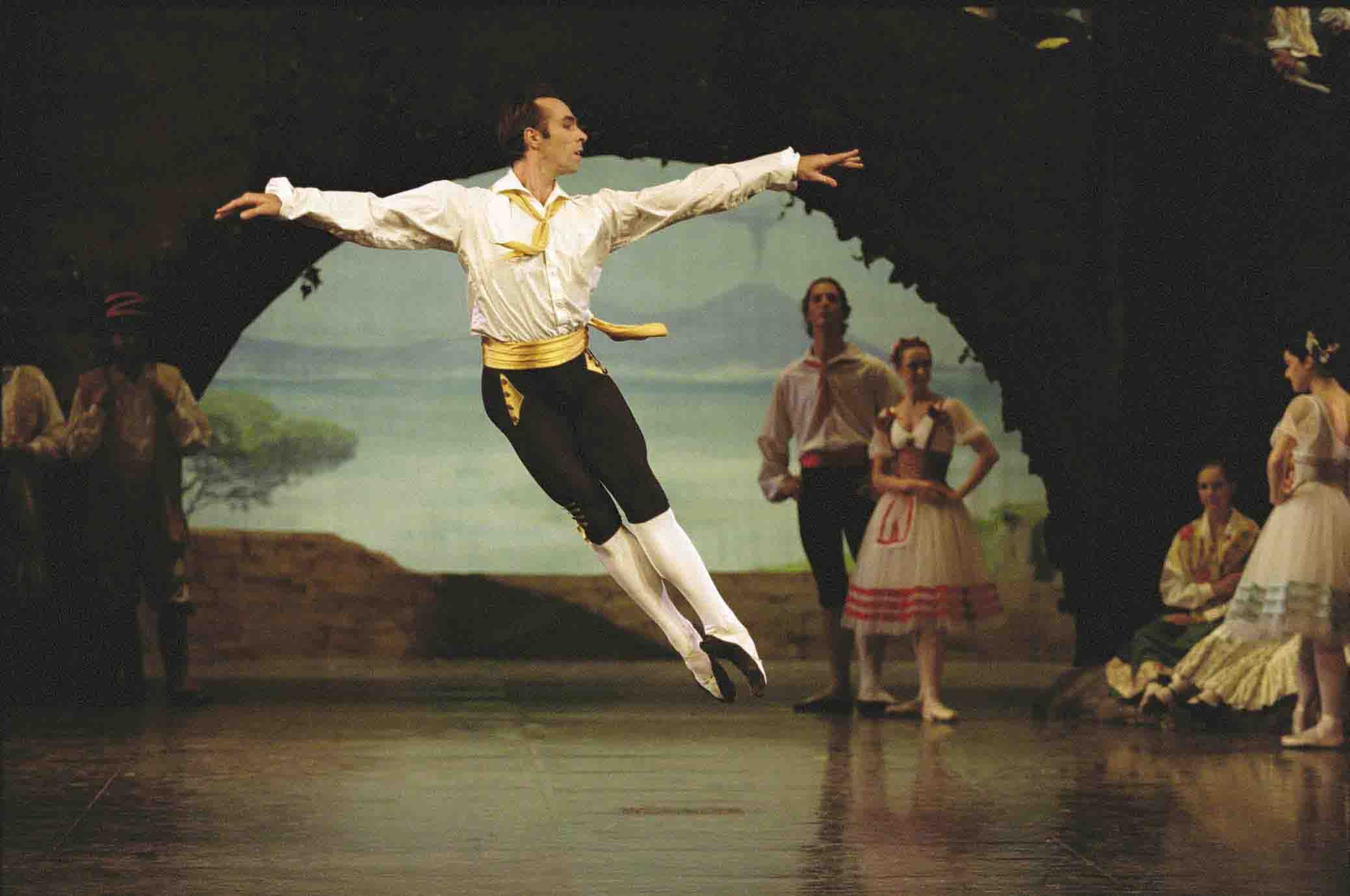 As its name suggests, Napoli is set in the shadow of Mt. Vesuvius—hence, perhaps, the volcanic temperament of its characters—and mixes the exuberant mime of this population with lusty folk dancing as well as classical dancing in both its poetic and bravura modes. The ballet tells a love story—among common folk, rather than the highborn favored by much 19th-century ballet—with its only to be expected contretemps and an untypical, for the period, happy resolution. (Bournonville’s optimistic outlook is one of his charms).
As its name suggests, Napoli is set in the shadow of Mt. Vesuvius—hence, perhaps, the volcanic temperament of its characters—and mixes the exuberant mime of this population with lusty folk dancing as well as classical dancing in both its poetic and bravura modes. The ballet tells a love story—among common folk, rather than the highborn favored by much 19th-century ballet—with its only to be expected contretemps and an untypical, for the period, happy resolution. (Bournonville’s optimistic outlook is one of his charms).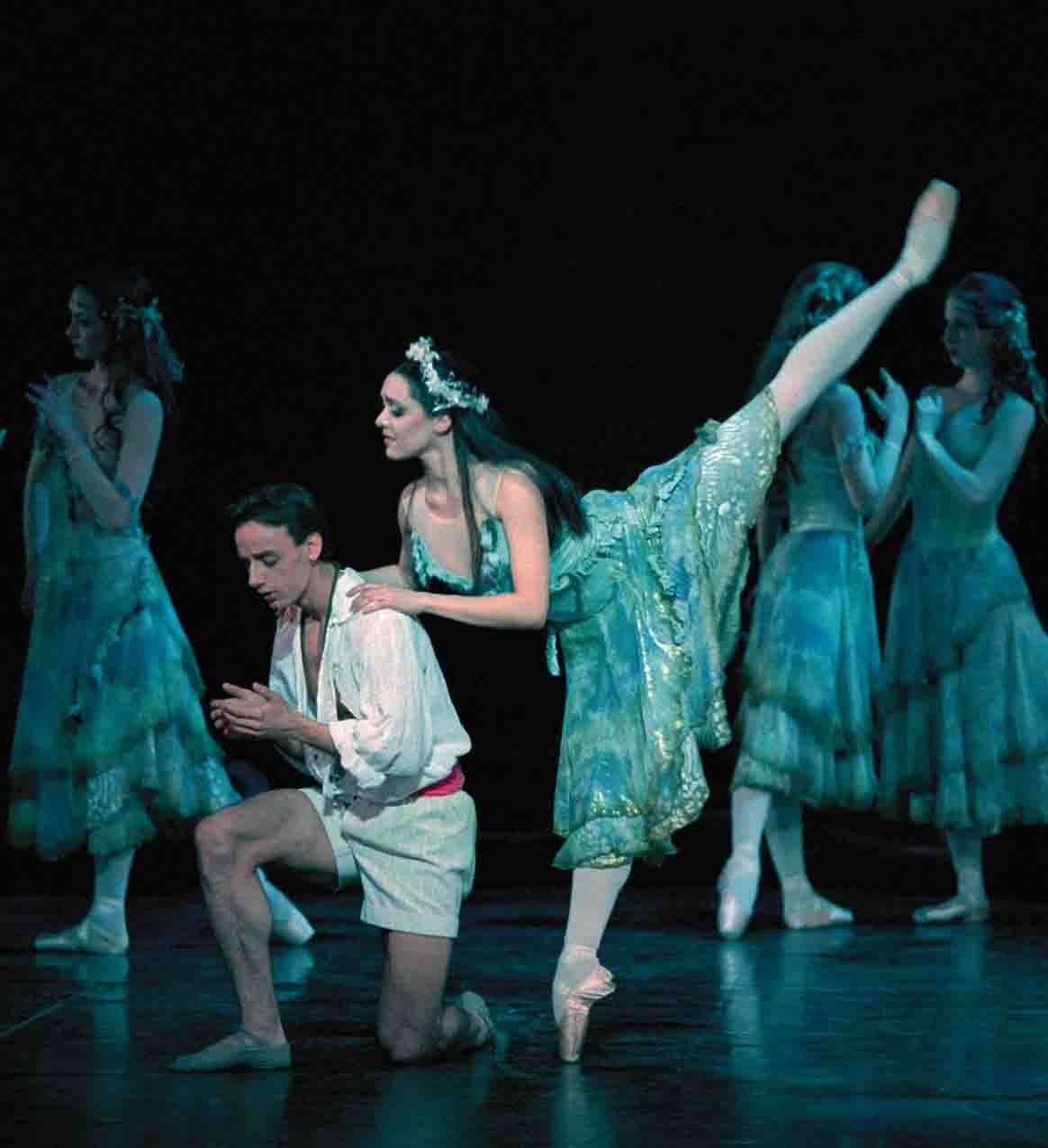 that charges through the assembled crowd straight down the middle of the stage, opening his arms in a wide curve as if to embrace the audience, he seems to be saying, “Here I am. Love me.” The appeal—all invitation, no ego—is impossible to resist, though Lund has neither the looks nor the build classical dancing prefers for its hero roles. Of course it would be wonderful if he had the physical glamour of gorgeous-to-die dancing Danes like Erik Bruhn, Henning Kronstam, Peter Martins, and Arne Villumsen. The gods, alas, are not always so generous.
that charges through the assembled crowd straight down the middle of the stage, opening his arms in a wide curve as if to embrace the audience, he seems to be saying, “Here I am. Love me.” The appeal—all invitation, no ego—is impossible to resist, though Lund has neither the looks nor the build classical dancing prefers for its hero roles. Of course it would be wonderful if he had the physical glamour of gorgeous-to-die dancing Danes like Erik Bruhn, Henning Kronstam, Peter Martins, and Arne Villumsen. The gods, alas, are not always so generous.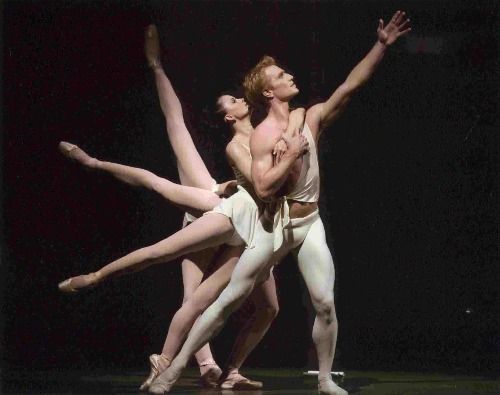 Balanchine’s Apollo, as the New York City Ballet danced it in the sixties, when I first laid eyes on it, was marked by a similar quality.
Balanchine’s Apollo, as the New York City Ballet danced it in the sixties, when I first laid eyes on it, was marked by a similar quality. repertoire, also fostered the dancers’ acting prowess, which has been further encouraged by latter-day additions of dramatic ballets to the company’s repertoire.
repertoire, also fostered the dancers’ acting prowess, which has been further encouraged by latter-day additions of dramatic ballets to the company’s repertoire. One might assume that the secret of the Danish school lay in a particularly ingenious or efficacious training system.
One might assume that the secret of the Danish school lay in a particularly ingenious or efficacious training system. Danish ballet’s teaching style emphasizes a
Danish ballet’s teaching style emphasizes a weekly gymnastics class–to build upper-body strength for lifting those girls over their heads and for, as an instructor put it, “joy and playfulness.”
weekly gymnastics class–to build upper-body strength for lifting those girls over their heads and for, as an instructor put it, “joy and playfulness.” they reach the age of 16.
they reach the age of 16. So what’s going on here?
So what’s going on here?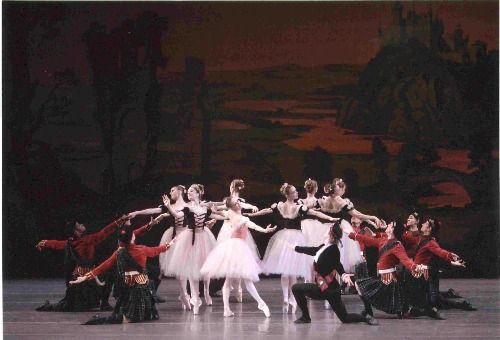 The 1952 Scotch Symphony, which has just entered the Balanchine 100 Centennial Celebration repertory, capitalizes on Highland local color—the valiant kilted men; the unobtainable female spirit haunting the foggy landscape; the portents of doom.
The 1952 Scotch Symphony, which has just entered the Balanchine 100 Centennial Celebration repertory, capitalizes on Highland local color—the valiant kilted men; the unobtainable female spirit haunting the foggy landscape; the portents of doom.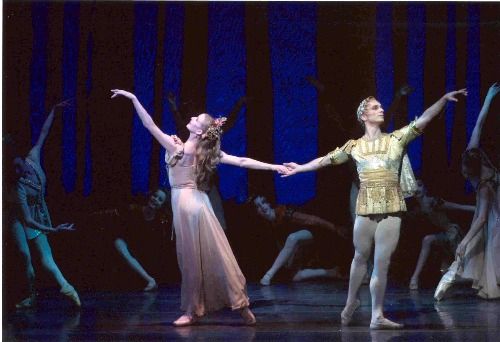 The atmosphere Balanchine invokes—of a fairyland that can absorb human incursions and is itself fully capable of folly—is big on charm.
The atmosphere Balanchine invokes—of a fairyland that can absorb human incursions and is itself fully capable of folly—is big on charm. Daria Pavlenko, dancing Odette-Odile, was far and away the best thing about the three performances I saw (all three casts) of the Swan Lake the Kirov Ballet brought to Kennedy Center. She has, beside formidable technique, the magisterial authority of a ballerina. This is rooted in the ability to draw the audience into an imaginary universe of which she is the center.
Daria Pavlenko, dancing Odette-Odile, was far and away the best thing about the three performances I saw (all three casts) of the Swan Lake the Kirov Ballet brought to Kennedy Center. She has, beside formidable technique, the magisterial authority of a ballerina. This is rooted in the ability to draw the audience into an imaginary universe of which she is the center.